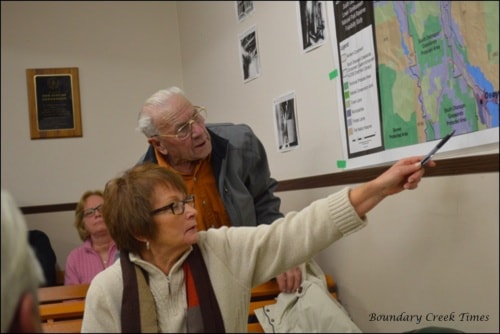The dream of establishing a national park in the South Okanagan- Similkameen is still very much alive.
Over the past ten years there has been considerable talk about establishing the park, but many of us living in the Boundary know little more about the proposal beyond being aware of the several large, homemade roadside signs that declare, “NO NATIONAL PARK!” that can be seen along the highway.
On the evening of November 26, representatives of the South Okanagan Similkameen National Park Network (SOSNPN) came to Greenwood city hall to gather support for a push to ask that the provincial government to enter negotiations with the federal government on establishment of the park.
Doreen Wilson is a coordinator for the grassroots group that stretches from Penticton to Keremeos. She’s been working on this issue since 2003.
Joining her was Chloe O’Loughlin, past executive director of the Canadian Parks and Wilderness Society (CPWS).
Some groups, including the CPWS, maintain that this park is essential for the protection of a unique ecosystem – the northern end of the Sonora desert, the only desert in Canada.
In 2003 the province announced their interest in the park and together with the federal government produced a proposal in 2006 for a big park (650 sq. km) that included Snowy Protected area.
O’Loughlin said that after consultation with communities the federal and provincial governments realized that the area was too big and the communities would not accept it. In 2010 a smaller area (284 sq. km) was proposed, with much of the western part of the earlier proposal removed.
In early 2012 the provincial government announced that although the national park was feasible they didn’t feel there was enough support at the time to move forward and withdrew from the process.
Polling found about 39 per cent of respondents slightly or strongly supported the proposed park, with about 19 per cent slightly or strongly opposed. The other 41 per cent said they neither supported nor opposed the proposal, didn’t know, or needed more information before deciding.
B.C. Environment Minister Terry Lake has said 39 per cent support simply wasn’t enough support to justify changes to logging, ranching, hunting and other activities in the area.
By law, the park establishment process is a joint process between the federal and provincial governments and once the province had withdrawn, the federal government was compelled to respect that decision and not move forward without the province in full partnership. Although O’Loughlin said that the federal government remains interested.
That’s where the SOSNPN comes in – the grass roots organization is lobbying to get the province back to the table. They encourage groups such as regional governments, local municipalities, tourism associations and chambers of commerce to come forward with formal motions supporting the park.
“We believe that parks are good for communities, conservation, recreation, jobs and the economy,” she told the gathering. “Parks Canada has a plan to have a little bit of every type of Canada protected in a national park. This part of Canada absolutely needs to have an area that is protected so it is there in perpetuity.”
In 2013 local First Nations, through the Okanagan Nations Alliance, completed a three-year study of the issue and according to O’Loughlin, “They are very interested in it and they unanimously supported the recommendation to ask the province to move forward. So if we can get the province and the federal government back talking again the next part of the process is to start negotiations.”
The negotiations would establish the boundaries and work toward resolving other issues. O’Loughlin said that should a formal agreement to establish the park be reached then Parks Canada would start to buy land as it becomes available on a willing seller, willing buyer basis.
O’Loughlin pledged that no existing businesses will be pushed out. “Their security will be assured through this negotiation,” she said. That would include ranchers and a helicopter training company. It is proposed that cattle ranching be continued in the park – the first time a national park has allowed grazing rights. O’Loughlin says there are risks if the land is not protected in a park.
For instance, some places in the area were identified for protected status by the Okanagan- Shuswap Land and Resources Planning table. One of the people attending the meeting was Bridesville rancher Joe Falkoski who represented mining interests at that table from 1995 to 2010. He explained that some of these areas have not yet been given full protection as Class “A” provincial parks yet because the province was waiting to see the outcome of the park establishment process.
It was noted that the land use plan is neither funded nor staffed; whereas national parks are historically given about ten times the amount of dollars that provincial parks get.
O’Loughlin said without park status both private and Crown land is at risk of being sold – the danger being the possibility that it would transfer to non-ranching interests and be sub-divided for development.
O’Loughlin pledged that no existing businesses would be pushed out. “Their security will be assured through this negotiation,” she said.
Then she encouraged everyone to consider the economic benefits of being in such close proximity to a national park - promising jobs, increased provincial revenue and tourists.
“All costs for a national park establishment and management are borne by the federal government. It would cost the province and the region and the communities nothing to bring this resource into the area.”
Both Midway mayor Randy Kappes and Greenwood mayor Nipper Kettle were at the November 26 meeting. SOSNPN presented the same information to Grand Forks Council in December.
Midway and Grand Forks have both written the province asking them to return to the table, but stopped short of endorsing establishment of the national park.
Greenwood is set to deal with the issue again this month.
